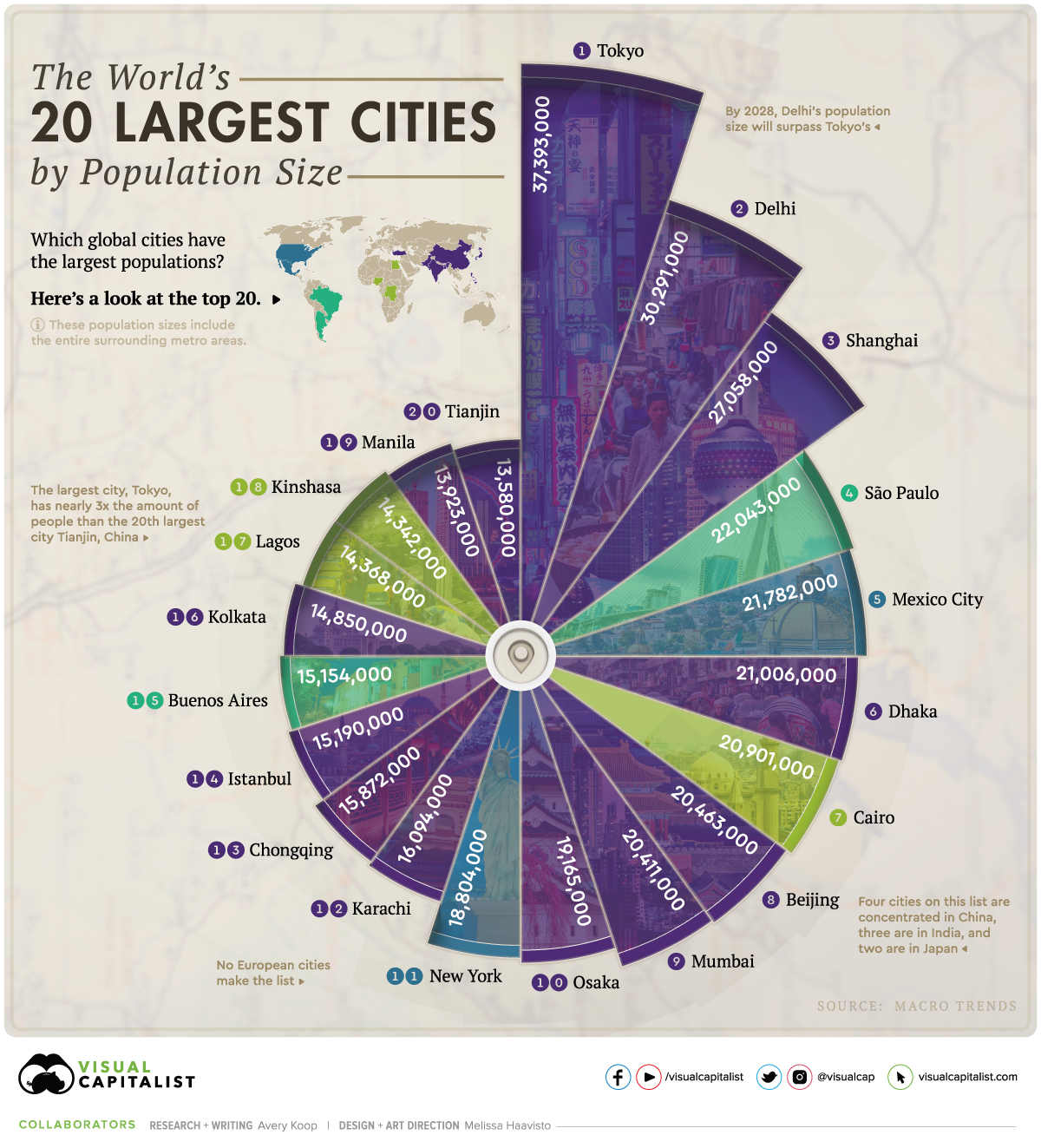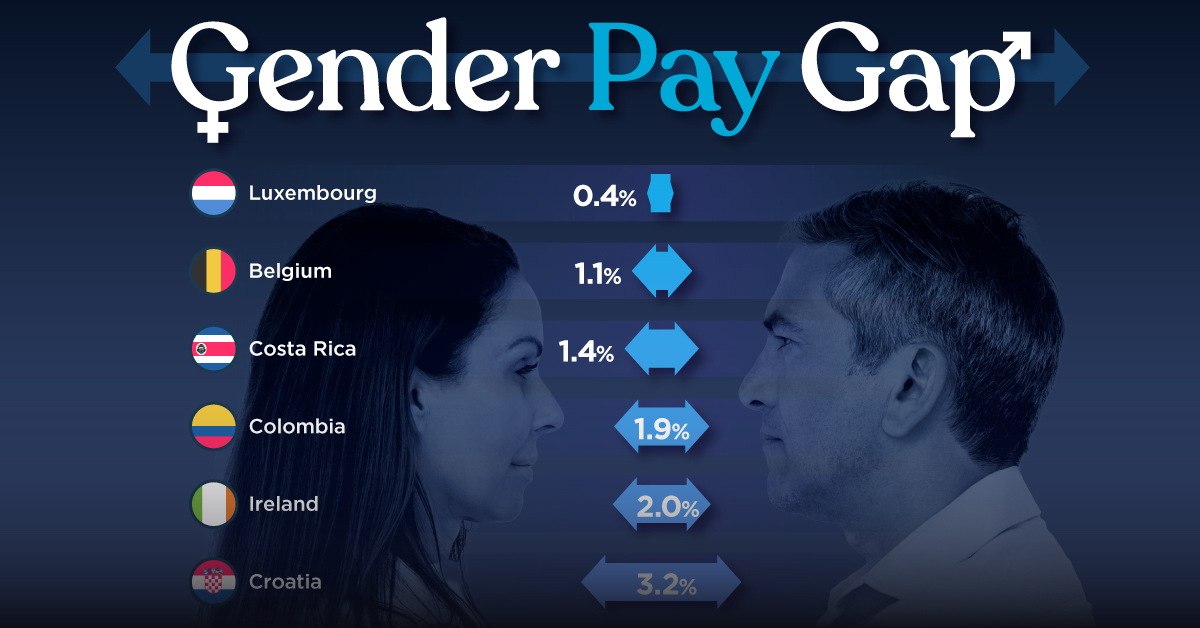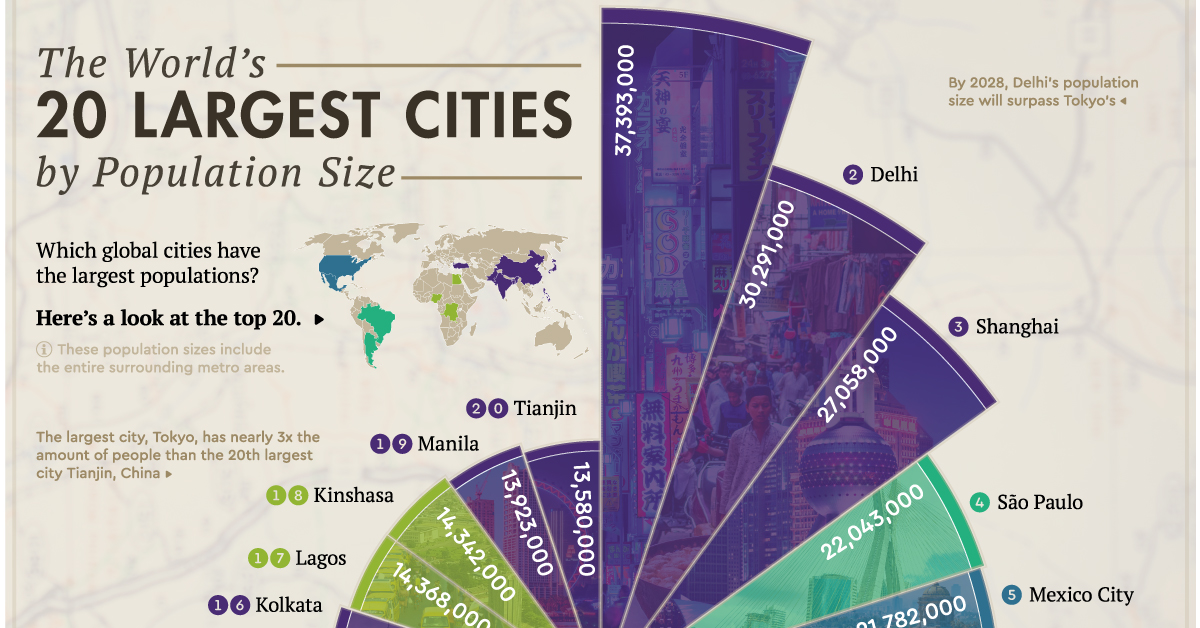Demographics
Ranked: The Most Populous Cities in the World

Ranked: The Most Populous Cities in the World
More than half of the world’s population currently lives in cities—and as time goes on, it’s clear that more urban dwellers will find themselves living in megacities.
Megacities are defined as urban areas with a population of more than 10 million people. This means that the world’s top 20 most populous cities are all megacities.
This visualization, using data from Macrotrends, shows the 20 most populous cities in the world.
Rapid Urbanization
Today, more than 80% of people in higher income countries find themselves living in urban areas, and in upper-middle income countries the number lies between 50-80%.
Rural-to-urban migration is an increasingly relevant trend in the 21st century. Prospects of better job opportunities and higher wages, along with shifts from agrarian to industrial and service-based economies, are causing mass movement to cities.
How much have the world’s five most populous cities grown in just the last decade?
| Rank | City | 2010 Population | 2020 Population | Percentage Change |
|---|---|---|---|---|
| #1 | 🇯🇵 Tokyo | 36,834,000 | 37,393,000 | +1.5% |
| #2 | 🇮🇳 Delhi | 21,935,000 | 30,291,000 | +38.1% |
| #3 | 🇨🇳 Shanghai | 19,980,000 | 27,058,000 | +35.4% |
| #4 | 🇧🇷 São Paulo | 19,660,000 | 22,043,000 | +12.1% |
| #5 | 🇲🇽 Mexico City | 20,132,000 | 21,782,000 | +8.2% |
While Tokyo only gained 559,000 people between 2010 and 2020, Delhi gained over 8 million people in the same time frame.
Shanghai grew by over 7 million people. Meanwhile, São Paulo grew by more than 2 million, and Mexico City gained just over 1.6 million people.
Interestingly, Mexico City placed third on the top largest cities list in 2010, but has since experienced slower growth compared to its competitors, Shanghai and São Paulo.
The Most Populous Cities Today
While Tokyo is the world’s most populous city with 37,393,000 people, this number is leveling out due to declining birth rates and an aging population.
Indian and Chinese cities, on the other hand, will continue to grow rapidly in the coming years. In fact, it’s expected that Delhi’s population could surpass Tokyo’s by 2028.
Here’s a closer look at the top 20 most populous cities.
| Rank | City | Population |
|---|---|---|
| 1 | 🇯🇵 Tokyo | 37,393,000 |
| 2 | 🇮🇳 Delhi | 30,291,000 |
| 3 | 🇨🇳 Shanghai | 27,058,000 |
| 4 | 🇧🇷 São Paulo | 22,043,000 |
| 5 | 🇲🇽 Mexico City | 21,782,000 |
| 6 | 🇧🇩 Dhaka | 21,006,000 |
| 7 | 🇪🇬 Cairo | 20,901,000 |
| 8 | 🇨🇳 Beijing | 20,463,000 |
| 9 | 🇮🇳 Mumbai | 20,411,000 |
| 10 | 🇯🇵 Osaka | 19,165,000 |
| 11 | 🇺🇸 New York City | 18,804,000 |
| 12 | 🇵🇰 Karachi | 16,094,000 |
| 13 | 🇨🇳 Chongqing | 15,872,000 |
| 14 | 🇹🇷 Istanbul | 15,190,000 |
| 15 | 🇦🇷 Buenos Aires | 15,154,000 |
| 16 | 🇮🇳 Kolkata | 14,850,000 |
| 17 | 🇳🇬 Lagos | 14,368,000 |
| 18 | 🇨🇩 Kinshasa | 14,342,000 |
| 19 | 🇵🇭 Manila | 13,923,000 |
| 20 | 🇨🇳 Tianjin | 13,580,000 |
By 2035, two new cities are expected to crack the top 20 list. Specifically, it’s projected that Bangalore (India) and Lahore (Pakistan) will boot out Tianjin and Buenos Aires. In addition, Guangzhou, Shenzhen, and Chennai are all expected to meet the megacity definition by 2035.
Urban growth will continue mainly in Asia and Africa, as some cities in regions such as Europe actually begin to shrink in population due to aging citizens and declining birth rates. Since 2012, deaths in the EU have actually been outpacing births—and in 2019, there were 4.7 million deaths compared to 4.2 million births, though net migration kept population numbers from falling.
Life in the City
While there are certainly downsides to mass urbanization, like pollution and overcrowding, the upsides clearly outweigh the negatives for most people. Convenience, better jobs, easier access to social services, and higher wages are among the many reasons people are likely to continue to move to cities, even in the post-COVID era.
With the emergence of smart and green cities, the quality of life for many urban dwellers will likely continue to improve, and more large urban areas will morph into megacities.
Demographics
The Smallest Gender Wage Gaps in OECD Countries
Which OECD countries have the smallest gender wage gaps? We look at the 10 countries with gaps lower than the average.

The Smallest Gender Pay Gaps in OECD Countries
This was originally posted on our Voronoi app. Download the app for free on iOS or Android and discover incredible data-driven charts from a variety of trusted sources.
Among the 38 member countries in the Organization for Economic Cooperation and Development (OECD), several have made significant strides in addressing income inequality between men and women.
In this graphic we’ve ranked the OECD countries with the 10 smallest gender pay gaps, using the latest data from the OECD for 2022.
The gender pay gap is calculated as the difference between median full-time earnings for men and women divided by the median full-time earnings of men.
Which Countries Have the Smallest Gender Pay Gaps?
Luxembourg’s gender pay gap is the lowest among OECD members at only 0.4%—well below the OECD average of 11.6%.
| Rank | Country | Percentage Difference in Men's & Women's Full-time Earnings |
|---|---|---|
| 1 | 🇱🇺 Luxembourg | 0.4% |
| 2 | 🇧🇪 Belgium | 1.1% |
| 3 | 🇨🇷 Costa Rica | 1.4% |
| 4 | 🇨🇴 Colombia | 1.9% |
| 5 | 🇮🇪 Ireland | 2.0% |
| 6 | 🇭🇷 Croatia | 3.2% |
| 7 | 🇮🇹 Italy | 3.3% |
| 8 | 🇳🇴 Norway | 4.5% |
| 9 | 🇩🇰 Denmark | 5.8% |
| 10 | 🇵🇹 Portugal | 6.1% |
| OECD Average | 11.6% |
Notably, eight of the top 10 countries with the smallest gender pay gaps are located in Europe, as labor equality laws designed to target gender differences have begun to pay off.
The two other countries that made the list were Costa Rica (1.4%) and Colombia (1.9%), which came in third and fourth place, respectively.
How Did Luxembourg (Nearly) Eliminate its Gender Wage Gap?
Luxembourg’s virtually-non-existent gender wage gap in 2020 can be traced back to its diligent efforts to prioritize equal pay. Since 2016, firms that have not complied with the Labor Code’s equal pay laws have been subjected to penalizing fines ranging from €251 to €25,000.
Higher female education rates also contribute to the diminishing pay gap, with Luxembourg tied for first in the educational attainment rankings of the World Economic Forum’s Global Gender Gap Index Report for 2023.
See More Graphics about Demographics and Money
While these 10 countries are well below the OECD’s average gender pay gap of 11.6%, many OECD member countries including the U.S. are significantly above the average. To see the full list of the top 10 OECD countries with the largest gender pay gaps, check out this visualization.
-

 Green2 weeks ago
Green2 weeks agoRanked: Top Countries by Total Forest Loss Since 2001
-

 Travel1 week ago
Travel1 week agoRanked: The World’s Top Flight Routes, by Revenue
-

 Technology1 week ago
Technology1 week agoRanked: Semiconductor Companies by Industry Revenue Share
-

 Money2 weeks ago
Money2 weeks agoWhich States Have the Highest Minimum Wage in America?
-

 Real Estate2 weeks ago
Real Estate2 weeks agoRanked: The Most Valuable Housing Markets in America
-

 Markets2 weeks ago
Markets2 weeks agoCharted: Big Four Market Share by S&P 500 Audits
-

 AI2 weeks ago
AI2 weeks agoThe Stock Performance of U.S. Chipmakers So Far in 2024
-

 Automotive2 weeks ago
Automotive2 weeks agoAlmost Every EV Stock is Down After Q1 2024


















